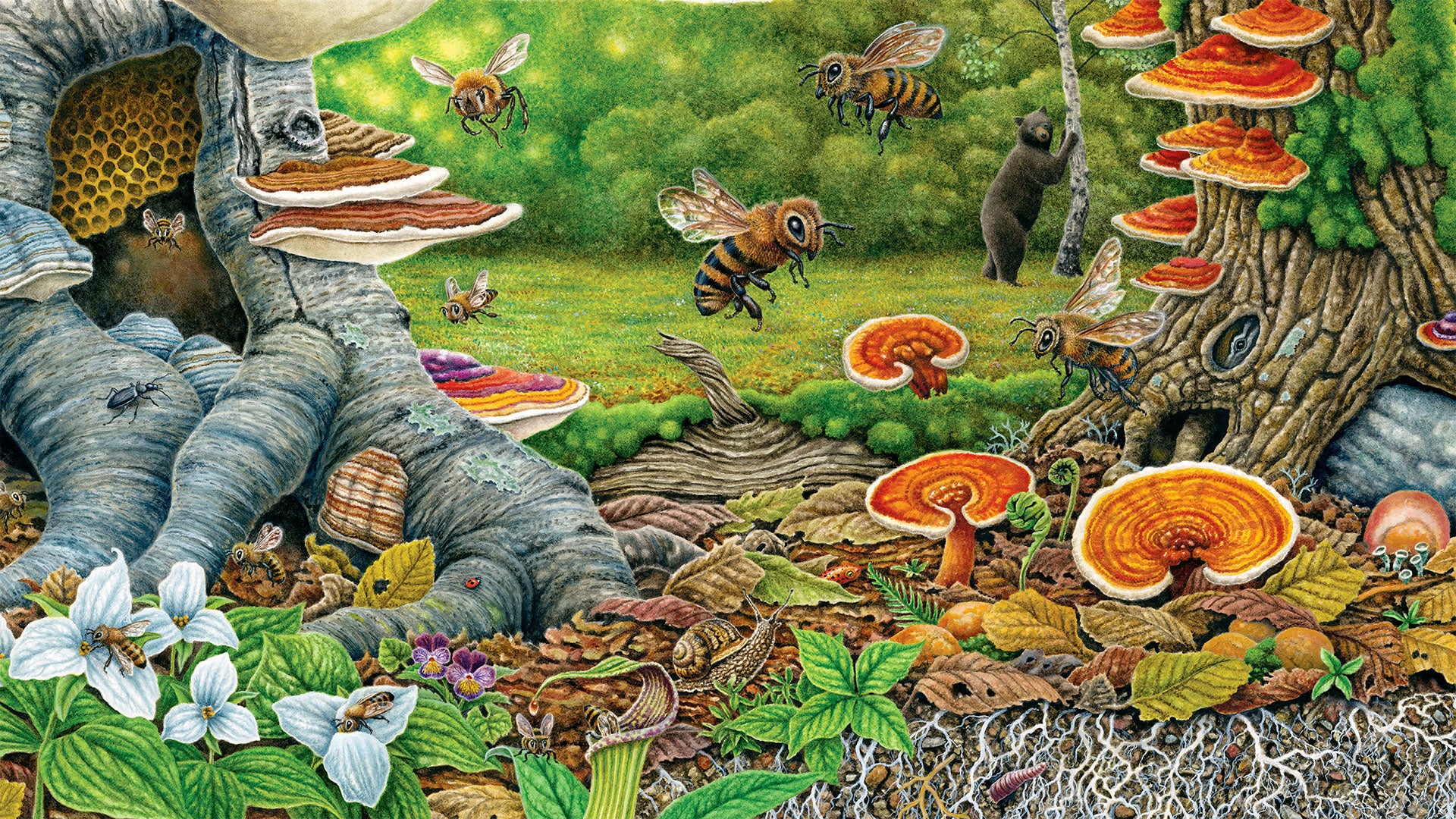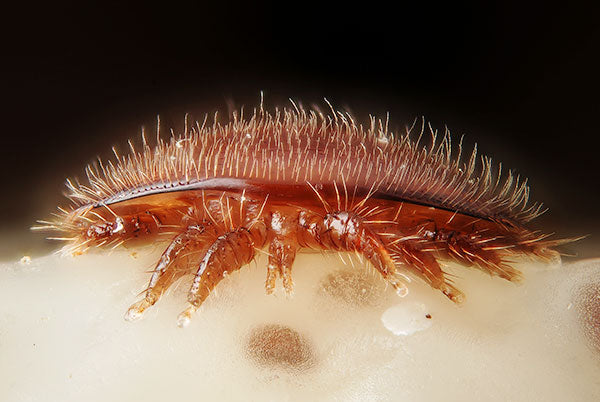
Bee Friendly Research Update 2
In our November 2014 newsletter you may have read about our Bee Friendly research initiative. This is what we are calling our research, development, and outreach campaign to draw attention to ways that fungi may be able to help reverse the devastating declines in the global bee population. Our approach stems from the philosophy that synergistic problems require outside-the-box thinking to discover synergistic solutions.

Apis mellifera, the Western Honey Bee
Over the past year, Fungi Perfecti, LLC has partnered with the Honey Bee Laboratory at Washington State University to research ways to use beneficial fungi to improve honey bee health. Scientists Walter S. Sheppard, PhD and Brandon K. Hopkins, PhD have begun preliminary bench-scale testing on two “MycoBee” approaches with generous financial support provided by the WWW foundation, Lee and June Stein, Paul Stamets, and Fungi Perfecti.
In the first set of bench-scale experiments, extracts of seven species of polypore fungi were fed to groups of caged honey bees to determine the effect of fungal extracts on captive life span and viral burden. For each type of extract, mixed aged honey bees from a single hive were collected on a single day and distributed at random into 16 cages of roughly 100 bees each. Each set of 16 consisted of four control cages (fed sugar syrup), four low concentration cages (fed mycelium extract in sugar syrup at 0.1% v/v), four medium concentration cages (fed mycelium extract in sugar syrup at 1% v/v), and four high concentration cages (fed mycelium extract in sugar syrup at 10% v/v). In each group of four cages, three cages were used for longevity tests and the remaining replicate cage was used for total viral particle testing.

The preliminary results suggest that fungal species and feeding concentrations vary considerably in their effect on honey bees. Some species, such as the Chaga mushroom (Inonotus obliquus) had no detectible effect on captive longevity at any concentration, while others, such as the red-belted polypore mushroom (Fomitopsis pinicola), appear to improve captive lifespan and may decrease viral burden at certain concentrations (see graph above). Additional experiments to confirm or refute these initial findings are currently underway and the research will be submitted to peer-reviewed journals for publication as results warrant.
A second set of bench-scale experiments is currently underway where the entomopathogenic fungus Metarhizium anisopliae is being investigated for its ability to control Varroa mite populations using non-spore-based delivery systems and mechanisms of action. While promising for its paradigm-altering potential for beekeeping, this research poses much greater logistical and scientific challenges for demonstrating efficacy and practicality than the longevity and antiviral research.

Female Varroa destructor mite on the head of a honey bee nymph. By Gilles San Martin from Namur, Belgium (CC BY-SA 2.0), via Wikimedia Commons.
Over the past ten years, Fungi Perfecti has developed novel approaches to fungal biocontrol, which have resulted in several proprietary technologies.[i, ii, iii, iv] These approaches include the preparation of fungal extracts to limit the spread of zoonotic diseases such as bee viruses, the development of fungal biocontrols that use “pre-sporulating” mycelium, and the use of extracts of entomopathogenic fungi as insect attractants. While developing Metarhizium anisopliae as a Varroa mite biocontrol product poses significant challenges, the strategic application of Fungi Perfecti’s original innovations may help turn the tide on this important research.
First, research with social insects has generally demonstrated that the presence of fungal spores induces specialized grooming behaviors designed to remove and limit transmission of potentially dangerous fungal pathogens.[v] This effect may partly explain why other researchers’ efforts to apply Metarhizium spores to bee hives to control Varroa mites have failed to provide effective control. Counter-intuitively, the pre-conidial (non-sporulating) mycelium of the same fungal species has powerful insect attractant properties.[vi]
Second, the use of dehydrated pre-conidial mycelium as a biocontrol delivery system may reduce the germination time required for spore-based approaches. Metarhizium spores generally require approximately 18 to 48 hours to germinate, and three to ten days to infect and kill Varroa mites.[vii] Notably, research by James demonstrated that spore germination rates decrease exponentially upon introduction to bee hive temperatures.[viii] The combination of these limitations points to a fundamental problem with the status-quo approach of applying spores as Varroa treatment. In contrast, dehydrated and powdered pre-conidial mycelium (aka hyphal fragments) of thermotolerant Metarhizium strains, may be able to resume active growth more quickly after re-hydration than spores. This approach is expected to significantly reduce issues of timing, concentration, and loss of viability after application in a hive.
In line with our multidisciplinary and synergistic philosophy for developing fungal-inspired treatments for improving bee health, our future research goals include:
- Development of concentrated fungal extracts that can selectively reduce honey bee viral burden when fed in sugar solution.
- Development of effective and practical Varroa mite control products.
- Testing the effect of fungal extracts on honey bee detoxicification pathways including cytochrome p450-mediated pesticide detoxification.
- Controlled field-scale testing and beta testing of bee health products after bench-scale optimization of preparations and application methods.
The research-to-date has been made possible by the generous support of individuals, companies, and private foundations. Continued financial support of the WSU Honey Bee Research Laboratory makes this novel research possible. If you would like to contribute to this research, donations to WSU can be made securely online here:
Just write “for honey bee fungus research” in the comments section.
Alternatively, checks can be sent directly to the bee program with a letter explaining the intent of the donation. Make checks payable to “Department of Entomology, WSU”:
PO Box 646382
Attention: Adam WIlliams
Department of Entomology
Washington State University
Pullman, WA 99164-6382
And of course, your continued support of Fungi Perfecti allows us to reinvest into research efforts such as this. Many thanks to all of you who aid us in these endeavors!
i Stamets, P. 2014. U.S. Patent # 8,765,138. “Antiviral and antibacterial activity from medicinal mushrooms.”
ii Stamets, P. 2014. U.S. Patent # 8,753,656. “Compositions for controlling disease vectors from insects and arthropods using preconidial mycelium and extracts of preconidial mycelium from entomopathogenic fungi.”
iii Stamets, P. 2015. U.S. Patent Application # 14/641,432: “Integrative fungal solutions for protecting bees.” Filed March 8, 2015.
iv Stamets, P. 2013. U.S. Patent # 8,501,207. “Mycoattractants and mycopesticides.”
v Reber A., Purcell J., Buechel S.D., Buri P., Chapuisat M. 2011. The expression and impact of antifungal grooming in ants. J. Evol. Biol. 24, 954–964.
vi Stamets, P. 2013. U.S. Patent # 8,501,207. “Mycoattractants and mycopesticides.”
vii Kanga LHB, Jones WA, Garcia C. 2006. Efficacy of strips coated with Metarhizium anisopliae for control of Varroa destructor (Acari: Varroidae) in honey bee colonies in Texas and Florida. Exp. Appl Acarol. 40:249-258. DOI 10.1007/s10493-006-9033-2.
viii James R.L. 2009. “Microbial Control for Invasive Arthropod Pests of Honey Bees,” in: Progress in Biological Control Volume 6 - Use of Microbes for Control and Eradication of Invasive Arthropods, Eds: Hajek A.E., Glare T.R., O’Callaghan M. Springer Science+Business Media B.V.

